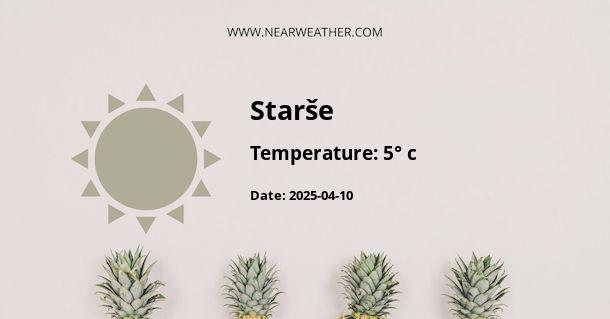Climate and Weather in Štarse, Slovenia
Štarse is a picturesque village nestled in the northeastern part of Slovenia, offering a climate that is characteristic of the country's varied topographical influences. Slovenia lies at the crossroads of major climatic zones, blending the influences of the Mediterranean, Alpine, and continental climate, which makes the weather in Štarse quite distinctive. Understanding the area's weather patterns requires an examination of its year-round climatic conditions, meteorological statistics, and predominant weather phenomena.
Overview of Štarse's Climate
Štarse experiences a temperate climate with distinct seasonal changes that range from warm summers to cold winters. The influence of the Mediterranean brings mild, wet conditions, especially in the autumn and winter months, while the presence of the Alps to the north moderates the temperatures, especially in the winter. The nearby Pannonian Plain also exerts an impact, occasionally bringing hot summers and cold winters.
Seasonal Weather Patterns
Spring
Spring in Štarse is a transitional season, with weather conditions moving from the cold and sometimes snowy winter to a milder and more variable climate. Temperatures start to rise slowly, but frost can still occur in the early months.
March to May Average Temperature Range: 2°C to 15°C (35°F to 59°F)
Average Precipitation: 70 mm (2.8 inches)
Summer
Summers are generally warm and can sometimes be quite hot, especially in late July and August, due to continental influences. However, this warmth is often accompanied by thunderstorms which can be quite heavy at times.
June to August Average Temperature Range: 15°C to 25°C (59°F to 77°F)
Average Precipitation: 105 mm (4.1 inches)
Autumn
Autumn brings cooler temperatures and increased rainfall. Fog can be frequent in the mornings, particularly in valleys and low-lying areas, while the afternoons tend to be clearer.
September to November Average Temperature Range: 6°C to 19°C (43°F to 66°F)
Average Precipitation: 85 mm (3.3 inches)
Winter
Winters in Štarse are relatively cold due to the effects of the nearby Alps. The village often experiences snowfall, and temperatures can drop below freezing, especially during the night.
December to February Average Temperature Range: -3°C to 3°C (27°F to 37°F)
Average Snowfall: 95 cm (37.4 inches)
Extreme Weather Events and Phenomena
Štarse, like much of Slovenia, can experience a range of extreme weather events. These occurrences include intense storms, severe winds known as "burja," and heatwaves during the summer months. Snowstorms and cold snaps are also known to occur in the winter, bringing much colder temperatures and heavy snowfalls.
Climate Data and Trends
To gain insights into the climatic conditions in Štarse, a more detailed look at the meteorological data is essential. The following table displays average monthly temperatures and precipitation, providing a snapshot of the area's weather:
| Month | Average High (°C) | Average Low (°C) | Average Precipitation (mm) |
|---|---|---|---|
| January | 2 | -5 | 40 |
| February | 5 | -3 | 35 |
| March | 10 | 0 | 70 |
| April | 15 | 5 | 70 |
| May | 21 | 10 | 80 |
| June | 24 | 14 | 100 |
| July | 26 | 16 | 100 |
| August | 26 | 15 | 90 |
| September | 21 | 11 | 100 |
| October | 15 | 6 | 90 |
| November | 8 | 1 | 80 |
| December | 3 | -3 | 60 |
Adaptation and Preparedness
With a climate that can swing between extremes, inhabitants and visitors of Štarse must be prepared for a wide range of conditions throughout the year. Proper clothing and an understanding of the seasonal variations are essential. Moreover, infrastructure must be resilient, especially concerning heating systems in winter and cooling systems in summer.
Effect of Climate Change
Climate change is beginning to make its presence felt in Štarse as well. The region has witnessed alterations in precipitation patterns and an increase in the frequency of extreme weather events like heatwaves and storms. These changes demand constant monitoring and potential adaptation strategies to mitigate their impact on human activities and the natural environment.
In conclusion, the climate and weather patterns in Štarse, Slovenia, present a dynamic and varied tapestry of conditions that can challenge both the residents and visitors to the region. Understanding these patterns, informed by statistical data and expert analysis, is critical for navigating life in this beautiful part of Slovenia—and planning for its future in a changing global climate.
A - Starše's Latitude is 46.465832 & Longitude is 15.767220.
A - Weather in Starše is 5° today.
A - Climate Conditions in Starše shows overcast clouds today.
A - Humidity in Starše is 87% today.
A - Wind speed in Starše is 5.54 km/h, flowing at 350° wind direction. today.
